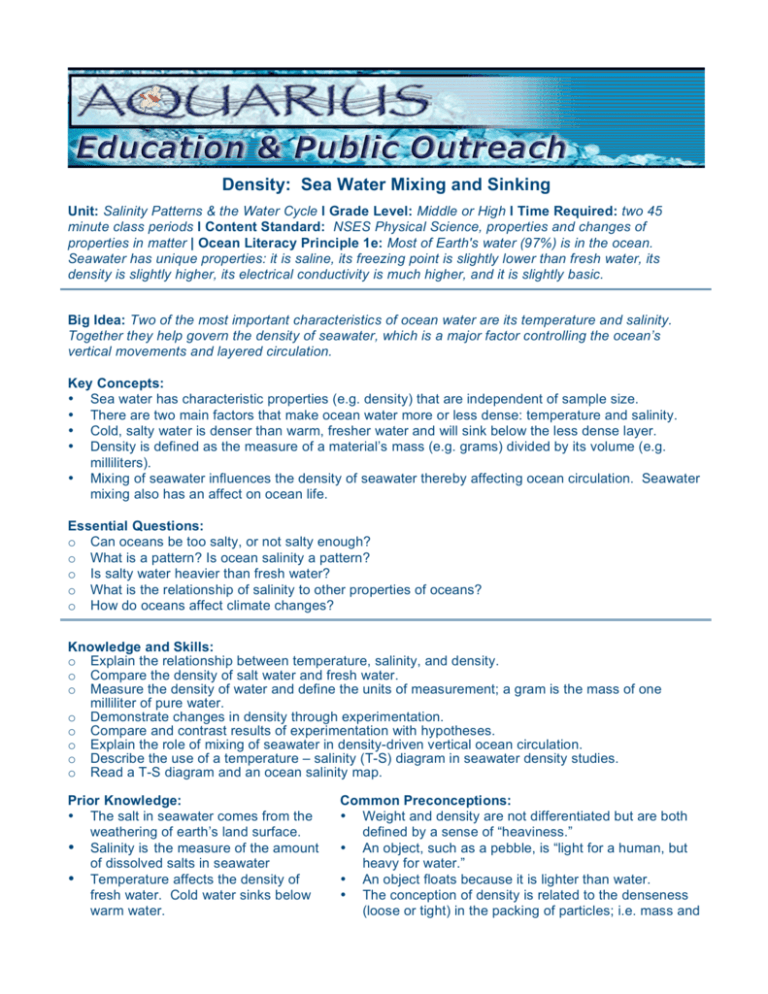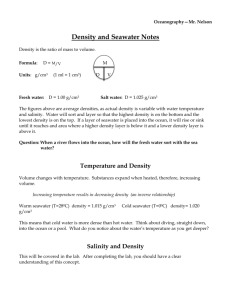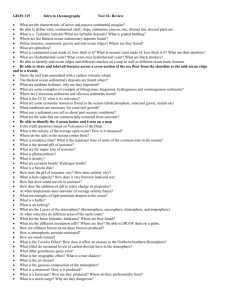Density: Sea Water Mixing and Sinking
advertisement

Density: Sea Water Mixing and Sinking Unit: Salinity Patterns & the Water Cycle l Grade Level: Middle or High l Time Required: two 45 minute class periods l Content Standard: NSES Physical Science, properties and changes of properties in matter | Ocean Literacy Principle 1e: Most of Earth's water (97%) is in the ocean. Seawater has unique properties: it is saline, its freezing point is slightly lower than fresh water, its density is slightly higher, its electrical conductivity is much higher, and it is slightly basic. Big Idea: Two of the most important characteristics of ocean water are its temperature and salinity. Together they help govern the density of seawater, which is a major factor controlling the ocean’s vertical movements and layered circulation. Key Concepts: • Sea water has characteristic properties (e.g. density) that are independent of sample size. • There are two main factors that make ocean water more or less dense: temperature and salinity. • Cold, salty water is denser than warm, fresher water and will sink below the less dense layer. • Density is defined as the measure of a material’s mass (e.g. grams) divided by its volume (e.g. milliliters). • Mixing of seawater influences the density of seawater thereby affecting ocean circulation. Seawater mixing also has an affect on ocean life. Essential Questions: o Can oceans be too salty, or not salty enough? o What is a pattern? Is ocean salinity a pattern? o Is salty water heavier than fresh water? o What is the relationship of salinity to other properties of oceans? o How do oceans affect climate changes? Knowledge and Skills: o Explain the relationship between temperature, salinity, and density. o Compare the density of salt water and fresh water. o Measure the density of water and define the units of measurement; a gram is the mass of one milliliter of pure water. o Demonstrate changes in density through experimentation. o Compare and contrast results of experimentation with hypotheses. o Explain the role of mixing of seawater in density-driven vertical ocean circulation. o Describe the use of a temperature – salinity (T-S) diagram in seawater density studies. o Read a T-S diagram and an ocean salinity map. Prior Knowledge: • The salt in seawater comes from the weathering of earth’s land surface. • Salinity is the measure of the amount of dissolved salts in seawater • Temperature affects the density of fresh water. Cold water sinks below warm water. Common Preconceptions: • Weight and density are not differentiated but are both defined by a sense of “heaviness.” • An object, such as a pebble, is “light for a human, but heavy for water.” • An object floats because it is lighter than water. • The conception of density is related to the denseness (loose or tight) in the packing of particles; i.e. mass and volume depend on the conception of the arrangement, the concentration, and the mass of particles. Concept Map: This lesson and activity relates to the branch “Properties of Water” from the comprehensive Aquarius Concept Map – Water & its patterns on Earth’s surface Activity 1 Measuring the Density of Water Background: Density is weight divided by volume. The density of fresh water is 1 gram (mass) per cubic centimeter (volume). In other words, if you had a cube with the dimensions: 1cm x 1cm x 1cm; and filled it with pure water, that cube of water would weigh 1 gram. This density is expressed as 1 g/cm3. If you dissolve salt into the water, the salt will increase the fluid’s mass, while its volume will remain the same. Thus, the liquid’s density will increase. Materials: Per student group – • graduated cylinders (50 or 100 ml), • 4 gm table salt • paper towels, • eyedropper, • scale (0 – 200 gm). Preparation: Distribute materials to student groups. Activity 1. o Determine the density of tap water: o Measure the mass of the empty graduated cylinder. Record the weight. o Fill the cylinder with water to the 100 ml line. This is the volume. o Measure the mass of the cylinder with water. o Subtract the mass of the empty cylinder from the mass of the filled cylinder. o Divide the mass of the water by its volume. This will yield the density of the tap water. Record your result. o Determine the density of tap water with salt: o Use an eyedropper to remove 2 g (2 ml) of water from the cylinder. o While the cylinder is on the scale, add 2 g of salt. o o o Read the new water level inside the cylinder. This is the new volume. Divide the mass of the water inside the cylinder by its new volume. This is the density of the salt water. Record your result. Compare the densities of the salt water and the fresh water. Activity 1. - Assessment / Questions o Ask students to write a brief paragraph describing their observations and results during the experiment, in addition to the following questions: − When you dissolved the salt into the water the liquid’s density increased, decreased, or stayed the same? (Choose one) Why? (The salt increases the fluid’s mass while its volume remains the same.) − How might the experiment have changed if the temperature of the water had been hot? Cold? Form hypotheses of predictions about temperature and density. o Discuss whether it will be easier for a person to float in salt water or fresh water. Why? Have any of the students noticed this difference? Activity 2. Sea Water Mixing and Sinking Background In the oceans, the salinity varies over time and from place to place. Typical open ocean salinities vary between 33 and 36 PSU (Practical Salinity Units), equivalent to 33-36 parts per thousand. Two of the most important characteristics of ocean water are its temperature and salinity. Together they help govern the density of seawater, which is the major factor controlling the ocean’s vertical movements and layered circulation. The following activity investigates the role of temperature and salinity in determining seawater density. It does so by using a Temperature-Salinity (T-S) Diagram to examine the effect of mixing on density. Such mixing can be a significant factor in causing surface seawater to sink as part of vertical circulation. The T-S Diagram is a simple, but powerful tool used in studies of seawater density, mixing, and circulation. In a T-S diagram, temperature is plotted along the vertical axis in degrees Celsius and salinity is measured along the horizontal axis in PSU. Seawater density is illustrated in the diagram by curved lines of constant density. Surface waters are mixed by winds and deep ocean water mixing is driven by density differences. Circulation in the depths of the ocean is referred to as thermohaline circulation. The deep ocean is layered with the densest water on bottom and the least dense water on top. Water tends to move horizontally throughout the deep ocean, moving along lines of equal density. Vertical circulation is limited because it is easier for water to move along lines of constant density (isopycnals) than across them. Materials: • Pencil, • T-S Diagram (below), • Water Sample Table (below) • Ocean Salinity map Preparation: None (although “Potato Float” is a good activity to acquaint students with the concept of densities of liquids). Activity 2 o As a class or in small groups, examine the Temperature-Salinity (T-S) Diagram (below). Temperature is plotted along the vertical axis in degrees Celsius (°C). Salinity is measured along the horizontal axis in Practical Salinity Units (PSU) that is numerically equivalent to parts per thousand (‰). Seawater density, in grams per cubic centimeter (g/cm^3), is shown on the diagram by curved lines of constant density. The value of each curved line appears immediately above each line. Note that temperature and salinity together govern the density of seawater. o As shown by the T-S Diagram, the density of seawater increases with increasing or decreasing temperature and with increasing or decreasing salinity. o On the T-S Diagram, each seawater sample is plotted as a dot (•) at the point determined by its temperature and salinity. Find the temperature and salinity for the two surface seawater samples o o o o o o o labeled “A” and “B” and record these values in the Water Sample Table (below). The density of seawater samples must be determined to several decimal places in order to detect significant differences. Read from the T-S Diagram the densities for the two surface seawater samples labeled “A” and “B” to the fourth decimal place. Record these values in the table. Note that their densities are the same. If surface waters of the same density are brought together, they tend to mix. The temperature and salinity of the resulting mixture are somewhere between the temperatures and salinities of the original waters prior to mixing. Record in the table, the temperature and salinity of a water sample “C” that would result if equal volumes of samples “A” and “B” were mixed together. (Hint: Mixing one liter of 10°C water with one liter of 30°C water produces two liters of water at 20°C.) Comparison of the seawater densities recorded in the table shows that the density of sample “C” is less than, equal to, or greater than (choose one) the density of samples “A” and “B” prior to mixing. On the T-S Diagram, draw a straight line between the points representing samples “A” and “B”. Any possible mixture of these seawater samples, including sample “C,” would be represented by a point falling somewhere on the straight line. Regardless of the relative volumes of seawater samples “A” and “B” mixed together, the T-S Diagram shows the resulting mixture will always be denser or less dense (choose one) than either “A” or “B.” Comparison of the density of surface seawater samples “A” and “B” with the density of any resulting mixture of these original samples indicate that the mixed water will remain at the ocean surface or sink (choose one). This can result in broad-scale motions that play significant roles in the layered circulation of the ocean. Have students make predications about where high and low salinity water might occur in the world’s ocean. Use the Global Ocean Salinity Map to verify predictions and discuss contradictions between the map and student predictions. This investigation shows that mixing surface seawaters of the same density, but different temperatures and salinities, produces seawater of greater, equal, or lesser (choose one) density. Vocabulary o buoyancy: In physics, an upward force on an object immersed in a fluid (i.e. a liquid or gas), enabling it to float or at least to appear to become lighter. If the buoyancy exceeds the weight, then the object floats; if the weight exceeds the buoyancy, the object sinks. o density: Mass per unit volume of a substance. Usually expressed as grams per cubic centimeter (gm/cm^3). o mass: The property of a body that causes it to have weight in a gravitational field. o practical salinity unit (PSU): Used to describe the concentration of dissolved salts in water, the UNESCO Practical Salinity Scale of 1978 (PSS78) defines salinity in terms of a conductivity ratio, so it is dimensionless. Salinity was formerly expressed in terms of parts per thousand (ppt) or by weight (parts per thousand or 0/00). That is, a salinity of 35 ppt meant 35 pounds of salt per 1,000 pounds of seawater. Open ocean salinities are generally in the range between 32 and 37. o salinity: A measure of the quantity of dissolved solids in ocean water. In general, salinity reflects the total amount of dissolved solids in ocean water in parts per thousand by weight after all carbonate has been converted to oxide, the bromide and iodide to chloride, and all the organic matter oxidized. o solute: A substance dissolved in another substance (the solvent) to create a solution. o specific gravity: The ratio of density of a given substance to that of pure water at 4°C and at a pressure of one atmosphere. o volume: The measure of three-dimensional space occupied by an object. Activity 1. Original source: San Juan Institute Activity Series and NASA’s “Visit to an Ocean Planet” CD-ROM Activity 2. Original source: Adapted from the Maury Project, American Meteorological Society Aquarius Education & Public Outreach URL: http://aquarius.nasa.gov/ Water Sample Table Sample A B C Temperature (°C) Salinity (PSU) Density (gm/cm^3)








